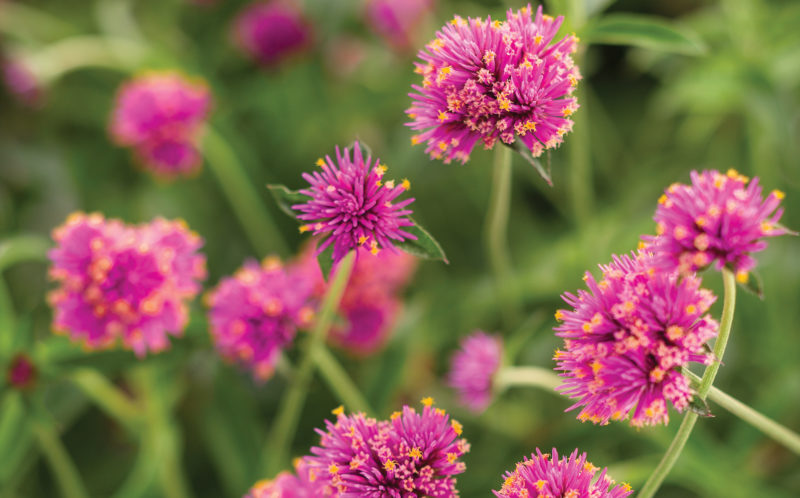
Culture Report: Gomphrena ‘Truffula Pink’
OK so maybe you did not get the Dr. Seuss reference in the name of this plant. So just do a quick internet search for “Dr. Seuss, Truffula Tree,” and you’ll catch on pretty quickly.
The important thing to know about ‘Truffula Pink’ is that it is an improved form of Gomphrena pulchella, native to the grasslands of Argentina, but with a more compact habit and a much higher degree of color coverage than any other gomphrena. Like all gomphrena it is heat, humidity, and low water tolerant, a magnet for pollinators, and easy for consumers to succeed with as well as easy for growers to produce.
Also keep in mind that this is a plant from the grasslands or prairies of Latin America, also known as the Pampas. This tells you a lot about ‘Truffula Pink’ because plants in the grasslands are adapted for full sun and in their native
homelands they are competing with grasses for water and nutrients. So they are tolerant of drier and less fertile situations, such as the average consumer’s front yard.
TRIAL PERFORMANCE
What we are seeing after a year in the 2018 National Public Trials program for ‘Truffula Pink’ is that 24 trial gardens rated the plant as a top performer with a season average of 4 out of 5 possible points or higher. Another 10 trial gardens gave the plant perfect scores or rated it among their Top 10 for the year.
‘Truffula Pink’ was in trials from Canada to the deep south, and from Colorado to Massachusetts; the key being all these plants were in full sun exposure and with average to low frequency watering and fertilizer. In November, there were still plants in full bloom in Phoenix, Arizona,
where even lantana struggles to perform in the intense summer heat and sunlight. So, in short, it was used in a wide range of conditions but the same high rankings for performance and impact in the landscape. With all these trials giving the plant a high ranking, it also means that their local markets will be looking for the plant in spring 2019 — definitely a buzzworthy year.
GROWING RECOMMENDATIONS
For the grower, there are a few key aspects of environment to keep in mind for the highest quality crops. Mainly it involves not bringing the plants in too early when conditions in the greenhouse are not yet ready for a crop this fast. Remember these plants are from warm grasslands, so they like warm production temperatures and they need that blazing sun to keep them compact and growing quickly.
Ideally the grower is going to be quick cropping through the spring with these plants. They set bud early and may take a shaping pinch, especially in early spring, but then they are going to finish fast and need to move to retail shelves.
• Keep ‘Truffula Pink’ plants warm throughout production, only dropping
temperatures to below 60° F when you want to hold them at salable size.
Otherwise, 65 to 75° F is best for growing on. Remember grow warm and finish fast, keep the crops turning over through the spring.
• Go easy on the watering. ‘Truffula Pink’ will do fine if allowed to dry slightly between waterings, especially if weather turns cold, but they do not like wet feet. So use care not to overwater especially early in production; once rooted in and actively growing they are trouble free.
• Keep light levels high. ‘Truffula Pink’ will tolerate an amazing amount of hot direct sun and benefit from it. This is why they do so well in the high deserts like Arizona, Utah and parts of Colorado. Intense sun just makes the plants look better and stay even tighter in habit.
• Avoid high ammonium-nitrogen source fertilizers; you want good stem strength and the ammonium-based fertilizers tend to weaken stems as well as encourage stem stretch. Another thing to watch is your fertilizer and your pH levels; ammonium-based fertilizers tend to lower pH over time and ‘Truffula Pink’ likes a slightly higher pH than some other bedding plants. Look for a nitrate nitrogen-based fertilizer with a full micronutrient complement for best results.
‘Truffula Pink’ is like many gomphrena in that its flowers are incredibly long lasting and are often called everlasting flowers. They are used as cut flowers, and as dried or pressed flowers. This everlasting quality also gives them a very long shelf life at retail.
We’re excited to promote this plant in 2019 with the trials track record it is holding. Pollinator attraction, along with heat and drought tolerance is what will make ‘Truffula Pink’ a unique addition to your crop portfolio. It can be used in containers or in the landscape and will also be a great addition to municipal landscapes.
QUICK CULTURE TIPS
pH: 6 – 6.5
EC: 0.6 – 0.9
FERTILIZATION: 150-200 ppm
LIGHT REQUIREMENTS: High
WATER CATEGORIES: Dry to moderate
ROOTING OUT TEMPERATURE: 65 to 72° F
GROWING ON TEMPERATURE: 65 to 75° F
HOLDING TEMPERATURE: 50 to 60° F
FINISHING TIMES: Five to seven weeks for 4- to 5-inch pots and quarts; six to eight weeks for 6-inch and gallon pots; seven to nine weeks for 7- to 9-inch pots; 10 to 12 weeks for 10- to 12-inch pots
PINCHING AND GROWTH REGULATORS: Pinch one to two weeks after transplant, a second pinch as needed for larger containers. Paclobutrazol at 1-3 ppm as a drench can help shape or hold the crop, but
go slowly and learn how the crop performs in your greenhouse.


 Video Library
Video Library 




















